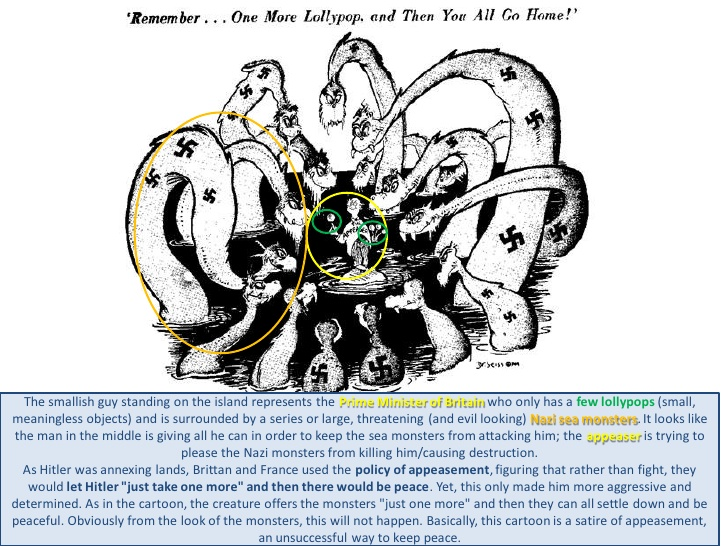CHAPTER 14 From Appeasement to War
Objective: students will be able to:
-Compare the German, Italian, and Japanese drives for empire in the 1930s, including the 1937 Rape of Nanking, other atrocities in China
-Understand the role of appeasement, nonintervention (isolationism), and the domestic distractions in Europe and the United States
-Identify and locate the Allied and Axis powers on a map and discuss the major turning points of the war, the principal theaters of conflict, key strategic decisions, and the resulting war conferences and political resolutions, with emphasis on the importance of geographic factors.
-Describe the political, diplomatic, and military leaders during the war (e.g., Winston Churchill, Franklin Delano Roosevelt, Emperor Hirohito, Adolf Hitler, Benito Mussolini, Joseph Stalin, Douglas MacArthur, Dwight Eisenhower).
Rationale:In the aftermath of World War I Totalitarian regimes grew from the rubble. The emergence of Mussolini, Hitler, Stalin, and Tojo would forever change the post-war landscape and put the world on a path to repeat the atrocities of the first World War but with superior weaponry and a more ruthless approach. Understanding the conditions which led to this rise is important, and can provide students a measuring stick in which to evaluate current political conflicts around the globe.
Objective: students will be able to:
-Compare the German, Italian, and Japanese drives for empire in the 1930s, including the 1937 Rape of Nanking, other atrocities in -Understand the role of appeasement, nonintervention (isolationism), and the domestic distractions in Europe and the
-Identify and locate the Allied and Axis powers on a map and discuss the major turning points of the war, the principal theaters of conflict, key strategic decisions, and the resulting war conferences and political resolutions, with emphasis on the importance of geographic factors.
-Describe the political, diplomatic, and military leaders during the war (e.g., Winston Churchill, Franklin Delano Roosevelt, Emperor Hirohito, Adolf Hitler, Benito Mussolini, Joseph Stalin, Douglas MacArthur, Dwight Eisenhower).
Rationale:In the aftermath of World War I Totalitarian regimes grew from the rubble. The emergence of Mussolini, Hitler, Stalin, and Tojo would forever change the post-war landscape and put the world on a path to repeat the atrocities of the first World War but with superior weaponry and a more ruthless approach. Understanding the conditions which led to this rise is important, and can provide students a measuring stick in which to evaluate current political conflicts around the globe.
Evidence:
Being able to list the conditions for the totalitarian rise, the effects of various totalitarian leaders on their countries, and the response of allied powers will give students a clear understanding of what caused World War II
___________________________________________________________________________________________
Essential Question -Appeasement, what is it, does it ever work

Journal Entry: Is appeasement a sign of weakness?
3 Edpuzzle Videos for background understanding
Treaty of Versailles Part 1
Treaty of Versailles Part 2
Questions - Edpuzzle Treaty of Versailles Part 1 & part 2 Question sheet on
For Tuesday:
Appeasement Section:
(Normally) You would be placed in partnerships based on the number of your seat. The odd number is partnered with the even number above them (i.e 1 is partnered with 2, 3 is partnered with 4, etc). You will be provided two sets of primary docs to review (odd number does A and B, Even number does C,D,E). Once you have finished the docs and written your hypothesis, each person will compare their hypothesis to see if there is an agreement or not. If agreed, identify what factors/reasons you agree on, if disagreement, identify what factors/reasons you disagree
(seeing we are in Covid 19 lockdown, simply select one or the other section to answer)
(On Google Classroom)
Guiding Questions A and B
Guiding Questions C, D, & E
Evidence:
Being able to list the conditions for the totalitarian rise, the effects of various totalitarian leaders on their countries, and the response of allied powers will give students a clear understanding of what caused World War II
___________________________________________________________________________________________
Essential Question -Appeasement, what is it, does it ever work
Journal Entry: Is appeasement a sign of weakness?
3 Edpuzzle Videos for background understanding
3 Edpuzzle Videos for background understanding
Treaty of Versailles Part 1
Treaty of Versailles Part 2
Questions - Edpuzzle Treaty of Versailles Part 1 & part 2 Question sheet on
For Tuesday:
Appeasement Section:
(Normally) You would be placed in partnerships based on the number of your seat. The odd number is partnered with the even number above them (i.e 1 is partnered with 2, 3 is partnered with 4, etc). You will be provided two sets of primary docs to review (odd number does A and B, Even number does C,D,E). Once you have finished the docs and written your hypothesis, each person will compare their hypothesis to see if there is an agreement or not. If agreed, identify what factors/reasons you agree on, if disagreement, identify what factors/reasons you disagreeTreaty of Versailles Part 2
Questions - Edpuzzle Treaty of Versailles Part 1 & part 2 Question sheet on
For Tuesday:
Appeasement Section:
(seeing we are in Covid 19 lockdown, simply select one or the other section to answer)
(On Google Classroom)
Guiding Questions A and B
Guiding Questions C, D, & E
Part 2 of Appeasement Section -(On Google Classroom)
Munich Pact Agreement
Munich Pact Questions
Appeasement Cartoon
CHAPTER OUTLINES
Chapter 14 Section #2 Outline - Due Wednesday Night (4/1)
(Google Classroom)
Part 2 of Appeasement Section -(On Google Classroom)
Munich Pact Agreement
Munich Pact Questions
Munich Pact Questions
Appeasement Cartoon
CHAPTER OUTLINES
Chapter 14 Section #2 Outline - Due Wednesday Night (4/1)
(Google Classroom)Chapter 14 Sectional Presentation
The Sectional Summaries are to be used as resources to assist with understanding the material
The Sectional Summaries are to be used as resources to assist with understanding the material









